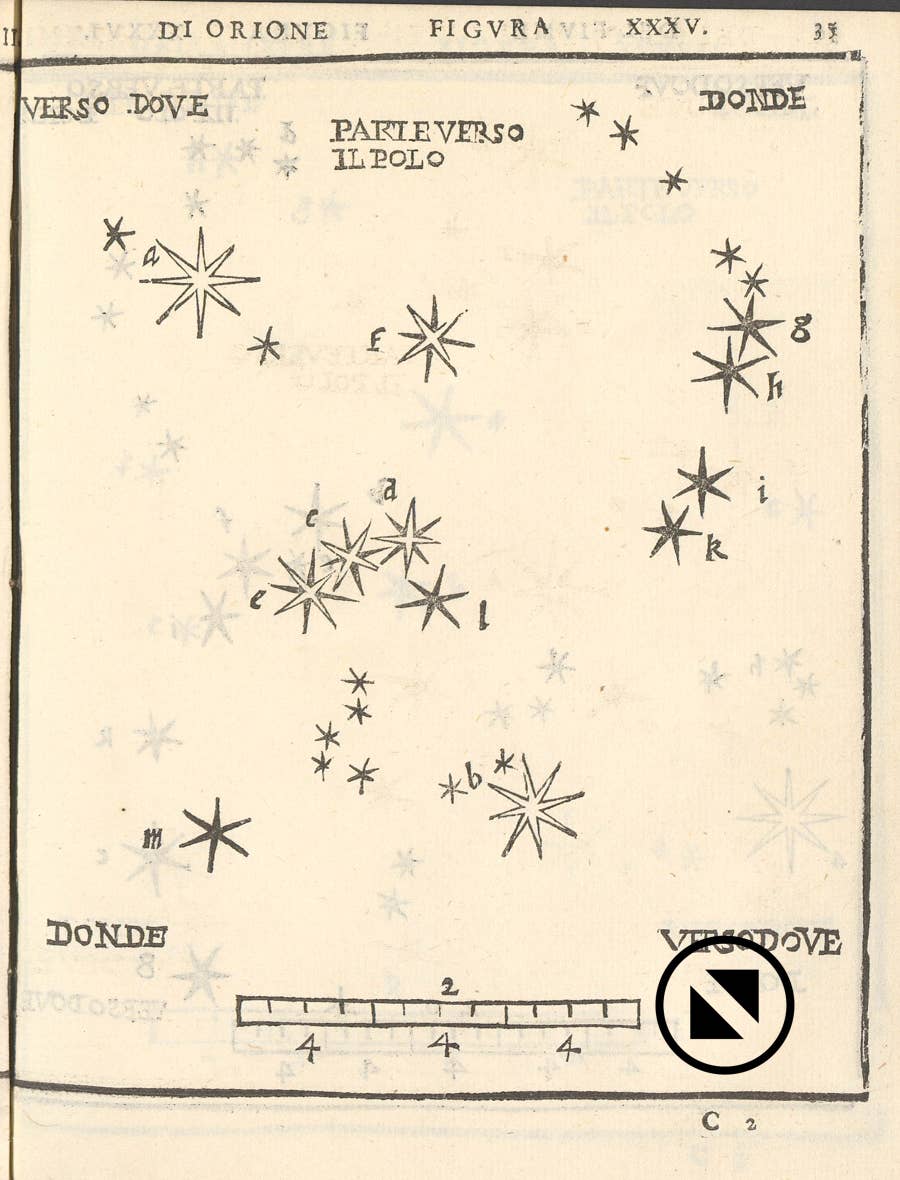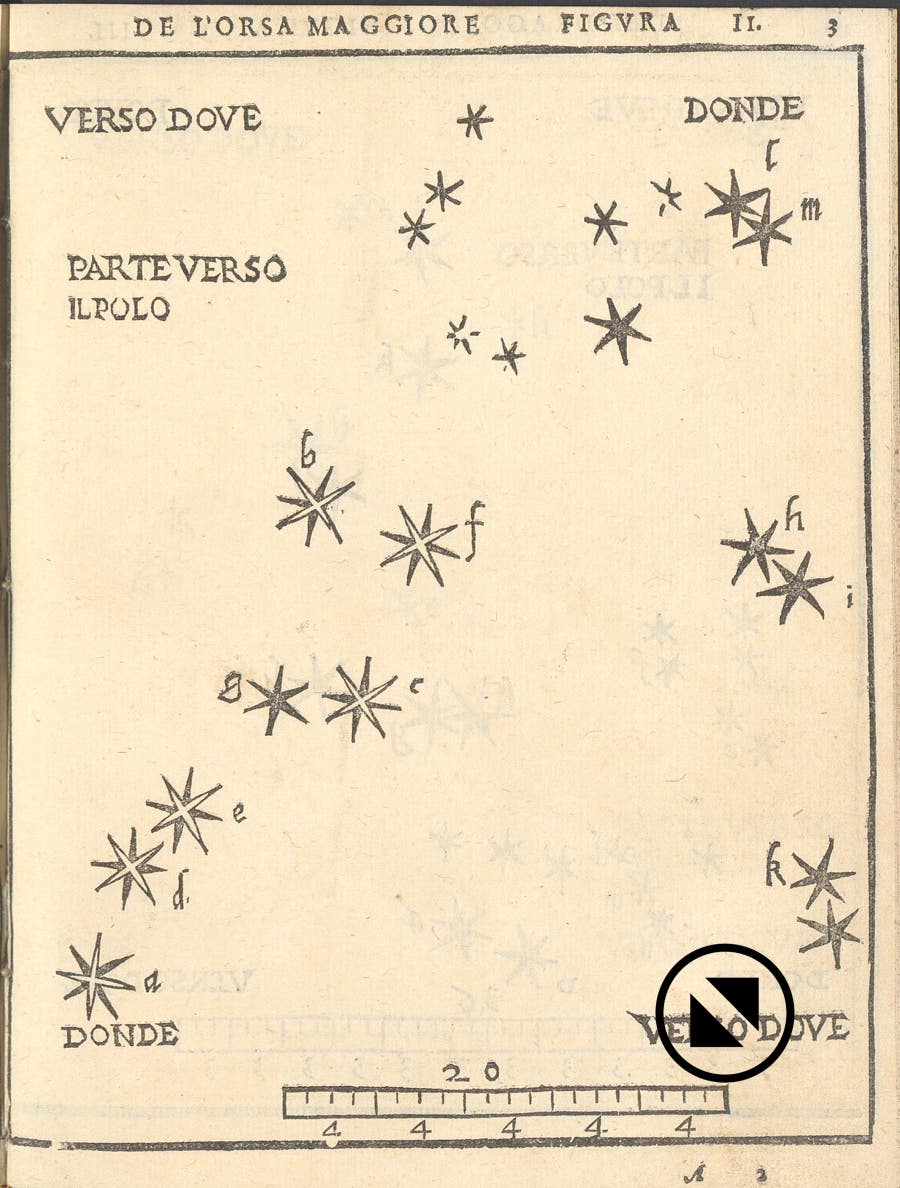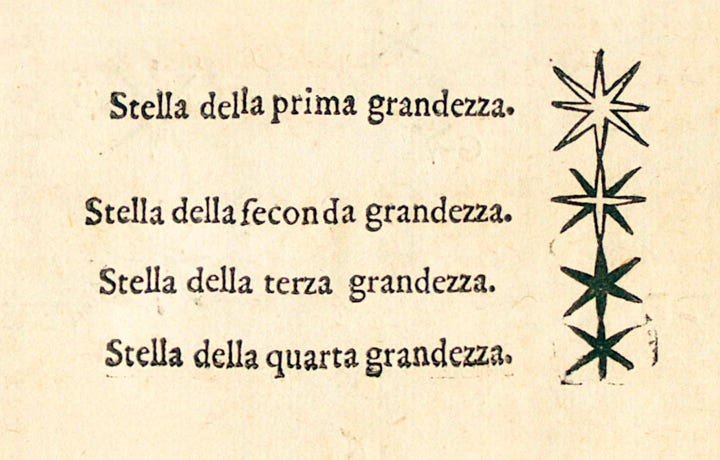Alessandro Piccolomini’s star atlas
In 1540 the Italian astronomer Alessandro Piccolomini (1508–79) published a handbook of astronomy called De le stelle fisse (On the fixed stars) which contained charts for 47 of the 48 Ptolemaic constellations, with stars down to 5th magnitude taken from the catalogue in the Almagest. Equuleus was the constellation missed out, because it had no stars bright enough for inclusion – Ptolemy had listed only four stars in it, all of which he described simply as ‘faint’.
Although quite crudely drawn, Piccolomini’s set of charts is generally regarded as the first true star atlas, as distinct from the single-sheet hemispheres drawn by Albrecht Dürer and his followers. Written in vernacular Italian rather than scholarly Latin, Piccolomini’s De le stelle fisse proved highly popular and went through more than a dozen editions over the following decades, often bound with another astronomical work of his, De la sfera del mondo (On the sphere of the world).
Whereas Dürer had numbered the stars of each constellation in the order they appeared in Ptolemy’s catalogue, Piccolomini labelled the brightest members with lowercase Roman letters, although with three exceptions: on the charts of Ursa Minor, Perseus, and Cetus the stars are labelled with capitals. The reason for this inconsistency is unknown, but could simply be a printer’s error. Piccolomini’s innovation was a forerunner of the more extensive system of Greek letters that Johann Bayer was to use over 60 years later in his Uranometria atlas of 1603.
Piccolomini’s chart of Orion from De le stelle fisse. Different-sized symbols indicate the magnitude of the stars, from 1st to 4th. Betelgeuse is labelled with a lowercase letter a and Rigel is labelled b. The stars of the belt are c, d, and e. Bellatrix is f. The four brightest stars of the shield are g, h, i, and k. Eta Orionis was l and Saiph was m. The letter j was not used. In some editions of the book, the letters i and l are missing because of an apparent printing error. North is at the top, indicated by the words ‘parte verso il polo’, while ‘verso dove’ (leading) and ‘donde’ (following) indicate how the constellation turns as the Earth rotates. This example is from the 1579 edition. (Image courtesy ETH-Bibliothek Zurich)
Piccolomini’s constellations were drawn face-on as they appear in the sky, rather than the mirror-image globe view of Dürer, which made the atlas more readily usable by observers. Four different sizes of star symbol were used, indicating the stars’ brightnesses from 1st to 4th magnitude as estimated by Ptolemy, although in some constellations Piccolomini included 5th-magnitude stars to make up the shape. In all, his charts plotted 621 stars. In the handbook he provided descriptions of each constellation and a mini-catalogue of the 455 brightest stars.
However, Piccolomini’s charts had many weaknesses. For one, north is not always at the top; the figures seem to have been turned whichever way they fitted best on the page. There were no coordinates for orientation; instead, north is indicated by the words ‘Parte verso il polo’, i.e. towards the pole, and the words ‘verso dove’ (towards, i.e. preceding) and ‘donde’ (whence, i.e. following) were added in the corners to indicate how the constellation moved as the sky rotated. Another drawback was that the charts were drawn to different scales, depending on the size of the constellation. An all-sky key chart to show the constellations in context would have been helpful, but there was none.
Piccolomini’s charts lacked the mythical constellation figures that made the planispheres of Dürer and Apianus so visually appealing, and despite their popularity at the time they had no influence on the magnificent pictorial atlases by Bayer, Hevelius, Flamsteed, and Bode that were to follow.
Piccolomini’s chart of Ursa Major. He presumably intended to letter the stars of the Big Dipper in order of brightness, but was unsuccessful because Ptolemy’s magnitude estimates were not precise enough. Bayer, by contrast, ignored minor differences in brightness and lettered the Dipper’s stars in order of increasing right ascension, from Alpha at the rim of the bowl to Eta at the end of the handle. Each of Piccolomini’s charts was sized to fit the page, so the scale differs between constellations. A scale bar in degrees was provided for reference at the bottom. Here, north is to the top left. (Image courtesy ETH-Bibliothek Zurich)
© Ian Ridpath. All rights reserved
Star symbols from first magnitude (‘prima’) to fourth (‘quarta’) used by Alessandro Piccolomini on his constellation charts. On some charts he also used smaller symbols for fainter stars.


